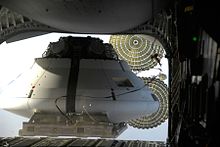
A drop test is a method of testing the in-flight characteristics of prototype or experimental aircraft and spacecraft by raising the test vehicle to a specific altitude and then releasing it. Test flights involving powered aircraft, particularly rocket-powered aircraft, may be referred to as drop launches due to the launch of the aircraft's rockets after release from its carrier aircraft.
In the case of unpowered aircraft, the test vehicle falls or glides after its release in an unpowered descent to a landing site. Drop tests may be used to verify the aerodynamic performance and flight dynamics of the test vehicle, to test its landing systems, or to evaluate survivability of a planned or crash landing. This allows the vehicle's designers to validate computer flight models, wind tunnel testing, or other theoretical design characteristics of an aircraft or spacecraft's design.
High-altitude drop tests may be conducted by carrying the test vehicle aboard a mothership to a target altitude for release.[1] Low-altitude drop tests may be conducted by releasing the test vehicle from a crane or gantry.[2]
- ^ "SNC building test schedule for Dream Chaser – Dryden Drop Tests upcoming". December 10, 2012. Retrieved March 31, 2013.
- ^ "NASA Fact Sheet - NASA's Gantry: Past, Present and Future Asset to Exploration". NASA.gov. Retrieved March 30, 2013.